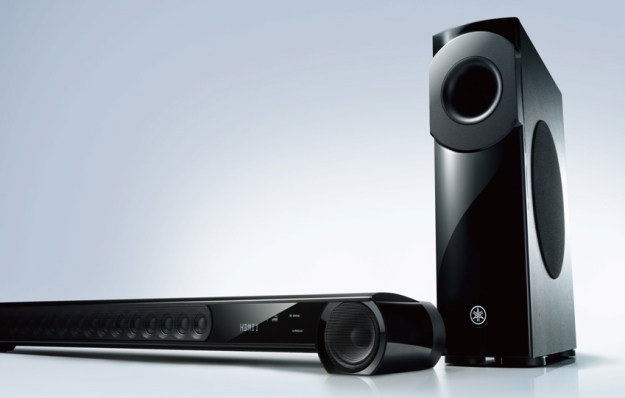
Yamaha has released its YSP-4300 and YSP-3300 digital sound projectors, offering home theater enthusiasts something to get giddy about in what’s been a bit of a slow February.
Both models come equipped with two wireless subwoofers and use a proprietary “beam” technology to create virtual 7.1-channel surround sound. Yamaha claims the technology can direct sound waves and is also useful for limiting exposure to audio, when the listener wants to be more discreet (i.e. the wee hours of the morning). The company calls this “target mode,” and, based on our experience listening to the sound bars that feature it, is something to get a little excited about.
Target mode handily dispatches with the problems that come with off-axis listening. Say your couch runs perpendicular to the wall your TV sits on, and well to the side; chances are you don’t get much of a stereo effect, and there is almost certainly a loss of the sensation that audio is coming from in front of you (center image). Target mode deals with this by “aiming” the sound wherever you direct it to, making it seem as if the speakers have been turned in your direction. For you, the sound is loud, clear, and accurately coincides with what you see on the screen – that’s a nifty trick on its own. But for those outside of the “target zone,” audio is sounds as if it has been placed on partial mute. The effect is dazzling.
The YSP-4300 sports 22 distinct beam drivers, and its brace of subs is powered by a 75-watt amplifier. The YSP-3300, on the other hand, shaves the driver count to 16 and its subs pack ⅓ less punch, at just 50W.
Both boast a slim, low-profile aesthetic, which should make integrating either unit into your setup a breeze, and there’s certainly nothing too ostentatious about the bar. In other words: It shouldn’t distract your eyes from that beautiful 84-inch 4K you snapped up as an impulse buy (if only …).
There’s a clear difference between the two models here, and the price reflects that discrepancy. The YSP-4300 weighs in a $1900, while the YSP-3300 weighs in at $1600. Ask us, and we’d tell you that if you’re going to shell out the $1600, you may as well cough up the extra $300 and nab the top dog. But we’re tech guys, not financial planners, so go with whichever model sounds right for you.


